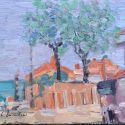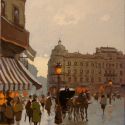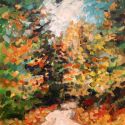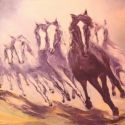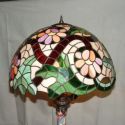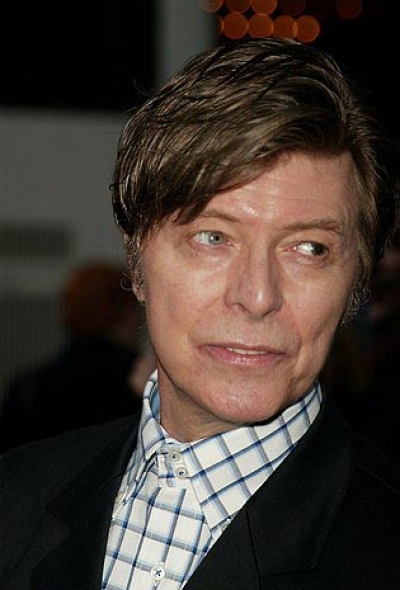
Foto: 1
Biography
He is commonly known as the chameleon of pop, predicting trends and adjusting his style and persona, while holding on to his own ideas and creativity. A multi-instrumentalist, he is famous for playing guitar, keyboard and saxophone; but also plays harmonica, drums, cello, marimba, bass guitar, koto and stylophone. He first rose to prominence with the heady, 1969 folk rock single "Space Oddity" but is perhaps best known for the single "Fame" from Young Americans (1975), and the flamboyant, androgynous glam rock of The Rise and Fall of Ziggy Stardust and the Spiders from Mars (1972), and Aladdin Sane (1973).
Subsequent albums have explored blue-eyed soul, electronica and new wave, often predating these genres' popularity or even the point at which they were defined as genres. The so-called "Berlin Trilogy", although receiving mixed commercial success at the time, is seen by many today as masterful and groundbreaking. After slumping sales in the mid- to late-1970s, Bowie again gained commercial success in the early 1980s with his hit single "Ashes to Ashes" and the album it came from, Scary Monsters (and Super Creeps) (1980). He reached his commercial peak with his singles "Modern Love," "China Girl" and "Let's Dance", the latter the title track of his very successful 1983 album. Many fans and neutral observers will argue that Bowie's consistency as a songwriter decreased afterwards.
Bowie has had a profound influence on rock music from the 1970s to the present. In the cable music network VH1's 2000 list of the 100 greatest artists of rock and roll, Bowie ranked seventh. In the British Broadcasting Corporation's list of 100 greatest Britons, Bowie ranked 29. He has sold an estimated 136 million albums in his career and has been inducted into the Rock and Roll Hall of Fame.
In addition to his musical career, Bowie has had success as an actor, starring in The Man Who Fell to Earth (1976), The Hunger (1983), Merry Christmas, Mr. Lawrence (1983), Labyrinth (1986), The Last Temptation of Christ (1988) and Basquiat (1996).
History
1947 to 1967: Early years
David Bowie, Space Oddity
David Robert Jones was born in Brixton, London on 8 January 1947, at this time his family home was at 40 Stansfield Road, although it is not known whether he was born at home or in hospital. It has been suggested that he may have been born as far away as Doncaster Royal Infirmary (see discussion page). He lived in Brixton until he was six years old, when his family moved to Bromley in Kent (now part of Greater London). He lived with his parents until he was eighteen.
Popular legend has it that in the spring of 1962, Bowie and his schoolmate, George Underwood, got into a fight over a girl which resulted in Bowie's peculiar eye condition. Underwood struck Bowie, who then hit his head sharply on the ground. At first, it appeared that Bowie would suffer only the usual bruises of a school yard fight but soon internal swelling developed, posing the threat of permanent blindness. Bowie was forced out of school for eight months so that doctors could conduct operations in attempts to repair his potentially blinded eye. Doctors could not fully repair the damage, leaving his pupil permanently dilated.
As a result of the injury, Bowie has faulty depth perception and his left eye, although naturally blue, now usually appears to be brown or green, a condition known as heterochromia. Bowie has stated that although he can see with his injured eye, his color vision was mostly lost and a brownish tone is constantly present. In any case, the difference between his eyes added an exotic element to his looks that would become a signature of his image.
Rumors that Underwood stabbed Bowie's eye with a compass or other implement are false but enduring. The two continue to be friends. Coincidentally, Underwood went on to do artwork for Bowie's earlier albums, including cover art for the famous Ziggy Stardust album. (see album covers).
Bowie stated that his earliest musical goal was to be a saxophone player in Little Richard's group. Initially a saxophonist, he was discovered, quite by accident, as a singer when he subbed in for a missing vocalist at a club in London. He played with various blues groups, such as "The King Bees," "The Manish Boys" and "The Lower Third" in the 1960s. Bowie's greatest strength throughout his career has been his ability to adapt his public image to fit, and often anticipate, the prevailing musical trends. His early work shifts through the blues and Elvis-esque music while working with many British pop styles.
Heavily influenced by the dramatic arts — from avant-garde theatre and mime to Commedia dell'arte—much of his work has involved the creation of characters or personae to present to the world. The aspiring rock star needed to use a different stage name to avoid confusion with Davy Jones of The Monkees, so he chose the last name Bowie after the Alamo hero Jim Bowie and his famous Bowie Knife. David pronounces "Bowie" to rhyme with "Joey".
Bowie released his first solo album in 1967 for Deram records, simply called David Bowie, an amalgam of Psychedelic Rock and Easy Listening. Also released was a single, "The Laughing Gnome", with the cult-classic B-side "The Gospel According to Tony Day". None of these managed to chart; the 1967 album is hard to find today, although it exists in counterfeit copies. However, the materials of the album, the single, and several other works were later recycled in a multitude of compilation albums.
1969 to 1973: Glam rock
His first flirtation with fame came in 1969 when his single "Space Oddity" which many people believe was released to coincide with the first moon landing, although David himself has claimed that this is untrue. This ballad was the story of what was often called Bowie's first dual-subject and role, Major Tom, an astronaut who becomes lost in space. It became a UK hit record. Its corresponding album was originally titled David Bowie and has caused some confusion, as both of Bowie's first and second albums were released with that name in the UK. In the US the second album bore the title Man of Words, Man of Music. While the album is not as hard to find as the original David Bowie, the highlights of the album are hardly well known. In 1972, the second album was re-released as Space Oddity.
On 19 March 1970, David married Mary Angela Barnett (now known as Angela Bowie) in Kent, England. Later that year, Bowie released The Man Who Sold the World, rejecting the acoustic guitar sound of the previous album and replacing it with the heavy rock backing provided by Mick Ronson, who would be a major collaborator through 1973.
Much of the album resembles British hard rock of the period, but the album provided some interesting musical detours, such as the title track's use of Latin sounds to hold the melody. The track provided an unlikely hit for UK pop singer Lulu and would be covered by many bands over the years, including Nirvana. The cover of the first release of this album, on which Bowie is seen reclining in a dress, was an early indication of his interest in exploiting his androgynous appearance.
His next record, Hunky Dory (1971) saw the partial return of the fey pop singer of "Space Oddity," with light fare such as the droll "Kooks" (dedicated to his young son known to the world as Zowie Bowie but legally named Duncan Zowie Heywood Jones). Other places, the album included some of his most harrowing lyrics on tracks such as "Oh! You Pretty Things" (this song was also taken to UK #12 by Herman's Hermits' Peter Noone in 1971), the semi-autobiographical "The Bewlay Brothers" and the Buddhist-influenced "Quicksand". Lyrically, the young songwriter also paid unusually direct homage to his influences with "Song for Bob Dylan", "Andy Warhol," and "Queen Bitch," which Bowie's somewhat cryptic liner notes indicate as a Velvet Underground pastiche.
As with the single "Changes", Hunky Dory was not a big hit but it laid the groundwork for the move that would shortly lift Bowie into the first rank of stars, giving him four top 10 albums and eight top ten singles in the UK in 18 months between 1972 and 1973.
Among Bowie's activities the next year were promoting and producing his rock and roll heroes. Former Velvet Underground singer Lou Reed's solo breakthrough Transformer was produced by Bowie and Mick Ronson. And Iggy Pop and his band The Stooges also signed with Bowie's management, MainMan Productions, and recorded their ultimate album, Raw Power, in London. Though he was not present for the tracking of the album, Bowie later performed its much debated mix.
Arguably, these credits did more to legitimize David Bowie as a rock music artist than any of his recordings to date. At the start of this intense period came Bowie's most highly regarded work, The Rise and Fall of Ziggy Stardust and the Spiders from Mars.
David Bowie in Ziggy Stardust attire
Bowie's androgynous image was taken a step further in June 1972 with the seminal Ziggy Stardust, a concept album around the career of an extraterrestrial rock singer. The album's sound returns to the hard rock lineup of Man Who Sold the World, but the feel is lighter and faster, typifying glam rock as pioneered by Marc Bolan. Many of the album's songs became rock classics, including "Ziggy Stardust," "Moonage Daydream," "Hang On To Yourself," and "Suffragette City".
Bowie's Ziggy Stardust character became the basis for his first tour beginning in 1972, where Bowie donned his famous red, flaming hair and wild outfits. The tour featured a three-piece band representing the "Spiders from Mars": Ronson on guitar, Trevor Bolder on bass, and Mick Woodmansey on drums. The album flew to #5 in the UK on the strength of the #10 placing of the single "Starman", as well as an interview where Bowie, as the first rock singer ever, freely admitted to being gay (though 'bisexual' was probably more accurate). The success of the album made Bowie a star, and soon the one-year-old Hunky Dory album went forth and eclipsed Ziggy Stardust, when it peaked at #3 on the UK chart. At the same time the non-album single John, I’m Only Dancing peaked at UK #12, and "All the Young Dudes", a song he had given to, and produced for, Mott The Hoople, made UK #3.
The same musicians came together on 1973's Aladdin Sane, another conceptual work about the disintegration of society, and Bowie's first #1 album in the UK. The album is sometimes called Bowie's "On the Road" album, because he wrote all the new songs on ship, bus or trains during the Ziggy Stardust tour. The album's cover, featuring Bowie shirtless with Ziggy hair and a red, black, and blue lightning bolt across his face, is one of the most famous covers of all time. Aladdin Sane included the UK #2 hit "The Jean Genie", the UK #3 hit "Drive-In Saturday", and a cover of The Rolling Stones' "Let's Spend the Night Together". Mike Garson joined Bowie to play piano on this album, and his performance has been called the album's highlight. As of 2005, Garson often plays in Bowie's band.
Bowie's later Ziggy shows, which included songs from both the Ziggy Stardust and Aladdin Sane records as well as a few earlier tracks like "Changes" and "Width of a Circle", were ultra-theatrical affairs, filled with some rather shocking stage moments, such as Bowie stripping down to a sumo wrestling loincloth or simulating fellatio with Ronson's guitar. Bowie took the character to extremes, touring and giving press conferences as Ziggy before a dramatic and abrupt onstage "retirement" at London's Hammersmith Odeon in 1973. His famous announcement -- "Not only is this the last show of the tour, but it's the last show that we'll ever do" -- was preserved as part of a live recording of the show, released as a double album under the title Ziggy Stardust - The Motion Picture.
Pin Ups, a collection of cover versions of 1960s hits, was released in 1973, spawning a UK #3 hit in "Sorrow" and itself peaking at #1, making David Bowie the best-selling act of 1973 in the UK. By that time, the "Spiders from Mars" were long split, and Bowie was trying to escape from his Ziggy persona. Bowie's own back catalogue was now highly sought. The Man Who Sold the World had been rereleased in 1972 along with the second David Bowie album (Space Oddity), whilst Hunky Dory's "Life on Mars?" was released as a single in 1973 and made #3 in the UK, the same year Bowie's nonsense record from 1967, "The Laughing Gnome," hit #6, embarassingly for Bowie.
The androgynous public and stage persona Bowie affected during this period sold records, but its popularity in gay culture and the emerging gay rights movement created controversy both in the US and in Britain, where homosexuality had only been legal since 1967. Bowie further stirred up controversy by publicly proclaiming himself bisexual, a claim he has since retracted and distanced himself from.
1974 to 1976: Soul, R&B, and The Thin White Duke
1974 saw the release of another ambitious album, Diamond Dogs, with a spoken word introduction and segued songs ("Sweet Thing/Candidate"). Diamond Dogs was the product of two distinct ideas — a musical based on a wild future in a post-apocalyptic city, and setting George Orwell's 1984 to music ("1984", "Big Brother", "We Are The Dead").
Bowie had planned on actually writing a musical to 1984, but his interest waned after encountering difficulties in licensing the novel, and he used the songs he had written for Diamond Dogs. The album — and an NBC television special, the 1980 Floor Show, broadcast at around the same time — demonstrated Bowie headed toward the genre of soul/disco music, the track "1984" being a prime example. The album spawned the hits "Rebel Rebel" (UK #5) and "Diamond Dogs" (UK #21), and itself went to #1 in the UK, making him the best-selling act of that country for the second year in a row. In the US, Bowie achieved his first major success when the album went to #5.
To follow on the release of the album, Bowie launched a massive Diamond Dogs tour of North America, lasting from June to December 1974. Choreographed by Toni Basil, and lavishly produced with theatrical special effects, this high-budget stage production broke with contemporary standard practice for rock concerts by featuring no encores. It was filmed by Alan Yentob for the documentary Cracked Actor.
Bowie commented that the resulting live album David Live ought really to be called "David Bowie Is Alive And Well And Living Only In Theory," presumably referring to his addled psychological state during this frenetic period. Nevertheless the album solidified his status as a superstar, going #2 in the UK and #8 in the US. It also spawned a UK #10 hit in a cover of "Knock On Wood".
After the opening leg of the tour, Bowie mostly jettisoned the elaborate sets. Then, when the tour resumed after a summer break in Philadelphia for recording new material, the Diamond Dogs sound no longer seemed apt. Bowie cancelled seven dates and made changes to the band, which returned to the road in October as the Philly Dogs tour.
To Ziggy Stardust fans who had not discerned the soul and funk strains already there in Bowie's recent work, the "new" sound was a sudden and very jolting step. 1975's Young Americans is his definitive exploration of Philly soul. It contained his first #1 hit in the US, "Fame," co-written with John Lennon (who also contributed backing vocals) and one of Bowie's new band members, guitarist Carlos Alomar. It was based on a version of James Brown's "Footstompin'," which Bowie's band had taken to playing live during the Philly Dogs period. One of the backing vocalists on the album is a young Luther Vandross.
Young Americans was the album which really made Bowie a star in the US; though only peaking there at #9, as opposed to the #5 placing of Diamond Dogs, the album stayed in the charts for almost twice as long. At the same time the album went #1 in the UK, and a re-issue of his old single "Space Oddity" became his first #1 hit in the UK, only a few months after "Fame" had become the same in the US.
1976's Station to Station featured a starker version of this soul persona, called The Thin White Duke. The figure seemed to be an extension of the character Thomas Jerome Newton in The Man Who Fell to Earth, whom Bowie played in the film. Station to Station presented a new direction in Bowie's music, with innovative use of synthesizer and electronic sounds and a lean towards German pop music. By this time Bowie was heavily dependent on drugs, especially cocaine, and many critics have attributed the chopped rhythms and emotional detachment of the record to the influence of the drug, which Bowie claimed to have been introduced to in America.
Nonetheless, there was another large tour in 1976, the Station to Station World Tour, which featured a starkly lit set and highlighted new songs such as the dramatic, lengthy title track, the romantic ballad "Word on a Wing," and the funky "TVC-15" and "Stay." The core band that coalesced around this album and tour — rhythm guitarist Alomar, bassist George Murray, and drummer Dennis Davis — would remain a stable unit through 1980.
With the album at #3 in the US, his greatest success there ever, and the single "Golden Years" becoming a transatlantic top 10 hit, Bowie was at a commercial peak, yet his sanity - by his own admission later - was twisted by cocaine and he overdosed several times during the year.
At around this time, Bowie became embroiled in a controversy caused by his comments to Playboy magazine apparently praising Hitler, and his statement that "Britain is ready for a fascist leader." He later pointed out that being "ready" for one and "needing" one are two different things. This was accompanied by some theatrics involving an open-top vintage Mercedes and what some claimed was a Nazi salute staged outside Victoria Station.
Bowie would later angrily deny being so "foolish" as to raise a Nazi salute, claiming that the photographer had caught him in mid-wave. This incident, along with similarly controversial racist remarks by Eric Clapton around the same time, were catalysts for the formation of the Rock Against Racism movement. Later, Bowie retracted his comments, excusing himself by claiming his judgment had been affected by substance abuse.
1976 to 1980: Brian Eno and the Berlin era
Bowie's interest in the growing German music scene and his drug addiction prompted him to move to Berlin to dry out and rejuvenate his career anew. Sharing an apartment in Schöneberg with his friend Iggy Pop, he produced three more of his own classic albums, as well as aiding Pop in his career. With Bowie as a co-writer and musician, Pop completed his first two solo albums, The Idiot and Lust for Life.
More unusually, the star Bowie joined Pop's touring band in the spring, simply playing keyboard and singing backing vocals. The group performed in the UK, Europe, and the US from March to April.
David Bowie, Best of 1974/1979
As for Bowie's music, the brittle sound of Station to Station was a precursor to that found on Low, the first of three recorded in collaboration with Brian Eno. Heavily influenced by the Krautrock sound of Kraftwerk and others, the new songs were relatively simple, repetitive and stripped, a clear and typically perverse reaction to punk rock, with the second side almost wholly instrumental. (By way of tribute, proto-punk Nick Lowe recorded an EP entitled "Bowi".) The album provided him with a surprise #3 hit in the UK when the BBC picked up the first single, "Sound and Vision", as its 'coming attractions' theme music. Low was renowned for having been far ahead of its time and fascinates to this day, many calling it Bowie's best album. It was produced in 1976 and released in early 1977.
The next record, "Heroes", was similar in sound to Low, though slightly more accessible. The mood of these records fit the zeitgeist of the Cold War, symbolized by the divided city that provided its inspiration. The title track remains one of Bowie's best known, a classic story about two lovers who met at the Berlin Wall.
Also in 1977, Bowie appeared on the ITV music show Marc, hosted by his close friend and fellow glam pioneer Marc Bolan, with whom he had regularly socialized and jammed since before either became famous. He turned out to be the show's final guest, as Bolan was killed in a car crash shortly afterwards. Bowie was one of many superstars who attended the funeral.
For Christmas, 1977, Bowie joined Bing Crosby, of whom he was an ardent admirer, in a recording studio to do a version of Little Drummer Boy, with new lyrics added. The two had originally met on Crosby's Christmas television special two years earlier (on the recommendation of his children - Crosby had not heard of Bowie) and performed the song. One month after the record was completed, Crosby died. The song was a worldwide festive hit. Bowie later remarked jokingly that he was afraid of being a guest artist, because "everyone I met dropped dead a month later", referring to Bolan and Crosby.
There was a brief world tour in 1978 which featured the music of both Low and "Heroes". A live album of this tour was released, known as Stage. Songs from both "Heroes" and Low were later converted to symphonies by minimalist composer Phillip Glass. 1978 was also the year that featured Bowie releasing a narration recording of Sergei Prokofiev's Peter and the Wolf, which to this day is regarded as one of the best recordings of the work.
Lodger (1979) was the final of Bowie's so-called "Berlin Trilogy" (this moniker has been debated as only "Heroes" was entirely recorded in Berlin, the collaboration with Brian Eno being the undisputed link amongst the three albums). Lodger featured the singles "Boys Keep Swinging", "DJ" and "Look Back in Anger", and it did not contain any instrumentals. However, the album is renowned for being quite a contorted mix of New Wave and world music, and pieces such as "African Night Flight" and "Yassassin" were surprising detours even by Bowie's standards. This was Bowie's last album with Eno until 1995's 1. Outside.
In 1980, Bowie did an about-face, integrating the lessons learnt on Low, Heroes, and Lodger while expanding upon them with breakthrough success. Scary Monsters (and Super Creeps) included the #1 hit "Ashes to Ashes", featuring the textural work of guitar-synthesist Chuck Hammer, and revisiting the character of Major Tom from "Space Oddity". The imagery Bowie used in the song's music video gave international exposure to the underground New Romantic movement and, with many of the followers of this phase being devotees, Bowie visited the London club "Blitz" - the main New Romantic hangout - to recruit several of the regulars (including Steve Strange of the band Visage) to act in the video, renowned as being one of the most innovative of all time. Scary Monsters clung to the principles that Bowie had learned in the Berlin era, however it was very fresh considering the brutal transformation Bowie had gone through during the experience. Bowie had divorced his wife Angie, gone through withdrawal from the drugs of the "Thin White Duke" era, and his conception of how music should be written had totally changed. The album had a very hard rock sound with many innovations, and it laid much of the foundation for rock music in the 1980s.
The 1980s: Bowie the superstar
David Bowie's wax figure at Madame Tussauds dressed as in the "Serious Moonlight Tour"
In 1981, Bowie released "Under Pressure", co-written by and performed with Queen. The song was a hit and became Bowie's third number one single as well as one of Queen's all time classics. The song appears on the Queen album Hot Space. In the same year Bowie made a cameo appearance in the German movie Christiane F, wir Kinder vom Bahnhof Zoo, the real-life story of a 13 year-old girl in Berlin who becomes addicted to heroin and ends up prostituting herself. Bowie is credited with "special cooperation" in the credits and his music features prominently in the movie. The soundtrack was released in 1982 and contained a version of "Heroes" sung partially in German.
Bowie then scored his first truly commercial blockbuster with Let's Dance (1983), a slick dance album with co-production by CHIC's Nile Rodgers. It was a departure from Scary Monsters for which Bowie received a bit of inside criticism; rather than revolting against 1980s dance music, he had defiantly joined the scene. The title track went to number one in the United States and United Kingdom: due to its popularity, many now consider it a standard. The album also featured the singles "Modern Love" and "China Girl", the latter causing something of a stir due to its suggestive promotional video. "China Girl" was remake of a song which Bowie co-wrote several years earlier with Iggy Pop, who recorded it for The Idiot. Let's Dance is also notable as a stepping stone for the career of the late Texan guitarist Stevie Ray Vaughan, who played on the album and was to have supported Bowie on his new world tour for the album The Serious Moonlight Tour. The tour was a huge success, and one concert actually scored Bowie a million dollars on its own. Vaughan, however, never joined the tour after a pay dispute between Bowie and Vaughan's manager at the time. Vaughan was replaced by Earl Slick.
The 1984 follow-up album Tonight was also dance-oriented, featuring collaborations with Tina Turner and a cover of The Beach Boys' "God Only Knows". Critics slammed it as a lazy effort, dashed off by Bowie simply to recapture Let's Dance's chart success. Yet the album bore the transatlantic top ten hit "Blue Jean" whose complete video, a 22-minute short film directed by Julien Temple, reflected Bowie's long-standing interest in combining music with drama. It also featured the minor hit "Loving the Alien". The album also has a pair of dance version rewrites of "Neighbourhood Threat" and "Tonight", old songs Bowie wrote with Iggy Pop which had originally appeared on Lust for Life.
In 1985, Bowie performed several of his greatest hits in a memorable performance at the Wembley leg of Live Aid. At the end of his set, he introduced a film of the Ethiopian famine, for which the event was raising funds, which was set to the song "Drive" by the Cars. At the event, the video to a fundraising single was premiered – Bowie duetting with Mick Jagger on a version of "Dancing In The Street", which quickly went to Number 1 on release.
In 1986 Bowie contributed the theme song to the film Absolute Beginners. The movie was not well reviewed but Bowie maintained for many years that the song, a UK Number 2 hit, was one of the best and most professional he'd ever written. He also took a role in the 1986 Jim Henson film Labyrinth as Jareth, the Goblin King, who steals the baby brother of a girl named Sarah (played by Jennifer Connelly), in order to turn him into a goblin. Bowie wrote songs for the film, some of which became singles.
Bowie's final dance album was Never Let Me Down (1987), where he ditched the light dance of his two earlier albums, instead throwing himself into harder rock with a dance edge. The album, which 'only' scraped to a UK #6 peak, drew some of the harshest criticism of Bowie's career, condemned by critics as a faceless piece of product and ignored by the public — Bowie himself openly apologized in an interview for the album's quality; defenders of the album maintain that many of its songs are underrated and that Bowie at this time was simply facing the inevitable backlash of an overexposed superstar.
Opening on May 30, 1987, The Glass Spider Tour sought to market the album; visiting fifteen countries and produced eighty six performances (mostly in stadiums), as well as nine promotional press shows. Musicians included: Carlos Alomar (guitar), Peter Frampton (lead guitar), Carmine Rojas (bass), Alan Childs (drums), Erdal Kizilcay (keyboards, trumpet, congas, violin) and Richard Cottle (keyboards, saxophone). Dancers included: Melissa Hurley, Viktor Manoel, Constance Marie, Craig Allen Rothwell (aka Spazz Attack), and Stephen Nichols. Some critics slammed it as being too silly, overproduced, and pandering in its special effects and dancers. However fans that saw the shows from that Glass Spider Tour were treated to many of Bowie's classics.
1989 to 1991: Tin Machine
In 1989, for the first time since the early 1970s, Bowie formed a regular band, Tin Machine, a hard-rocking quartet, along with Reeves Gabrels, Tony Sales, and Hunt Sales. Tin Machine released two studio albums and a live record. The band received mixed reviews and a somewhat lukewarm reception from the public, but Tin Machine heralded the beginning of an ongoing collaboration between Bowie and Gabrels.
The original album, Tin Machine (1989), was a success, holding the number 3 spot on the charts of the UK. Tin Machine launched its first world tour, featuring a now unshaven David Bowie, that year. Despite the success of the Tin Machine venture, Bowie was mildly frustrated that many of his ideas were either rejected or changed by the band.
Bowie began the 1990s with a stadium tour, in which he played mostly his biggest hits. The "Sound Vision Tour" (named after the Low single) drew large crowds, perhaps in part because he had declared that this would be the last time he would play the hits. Though he surprised no one when he later reneged on that promise (and also on the promise that his set in each country would be focused on the favorite hits voted by phone poll in that country... an idea quickly jettisoned when a puckish campaign by the British magazine NME resulted in a landslide in favor of The Laughing Gnome!), it is true that his later tours generally featured few of those hits, and when they appeared, they were often radically reworked in their arrangement and delivery.
After the less successful second album Tin Machine II and the complete failure of live album Oy Vey, Baby, Bowie tired of having to work in a group setting where his creativity was limited, and finally disbanded Tin Machine to work on his own. But the Tin Machine venture did show that Bowie had learned some harsh lessons from the previous decade, and was determined to get serious about concentrating on music more than commercial success.
1992 to 1999: Bowie's solo career in the 90's
1993 saw the release of the soul, jazz and hip-hop influenced Black Tie White Noise, which reunited Bowie with Let's Dance producer Nile Rodgers. Though considered by some critics to be musically far superior to Let's Dance, the public was still unsure whether or not it was ready to be receptive to Bowie again. The album, however, met the number one spot on the UK charts with singles such as "Jump They Say" and "Miracle Goodnight". However, until re-releases later in the 1990s, the album was extraordinarily rare after the fledgling Savage Records on which it had been released suddenly went belly-up. The album is often considered Bowie's oddest departure.
Undaunted, Bowie explored new directions on albums such as 1993's The Buddha of Suburbia (built on incidental music composed for a TV series). The album still contained some of the new elements introduced in Black Tie White Noise, except with more of a twist in the direction of alternative rock. The album's odd success later led to a 1994 re-release in the United States, and Bowie hails it as being an album of entirely his own, original, and newly created work.
1995's ambitious, quasi-industrial 1. Outside, supposed to be the first volume in a subsequently abandoned nonlinear narrative of art and murder, reunited him with Eno. The album introduced the characters of one of Bowie's short stories, and was quite an interesting success. The album put Bowie back into the mainstream scene of rock music with its singles such as "Hallo Spaceboy" and "The Heart's Filthy Lesson". In September of 1995 Bowie began his the Outside Tour with Gabrels again joining Bowie as his live band's guitarist. In a move that was equally lauded and ridiculed by Bowie fans and critics, Bowie chose Trent Reznor's Nine Inch Nails as the tour partner. NIN & Bowie toured as a co-headlining act. Although initially successful, the tour was cancelled early due to poor sales. However, Reznor has gone on record numerous times as being heavily influenced by Bowie, and further collaborated with him by remixing "The Heart's Filthy Lesson".
1997's Earthling incorporated experiments in jungle and drum and bass and included a single released over the Internet, called "Telling Lies." There was ultra-sustained energy in this album, along with experiments in techno drum rhythms, while still holding to Bowie's own musical concepts. Singles such as "Little Wonder" and "I'm Afraid of Americans" (also remixed by Reznor) were the forefront of the album. There was a corresponding world tour, which was fairly successful.
On 9 January 1997, Bowie played a concert at Madison Square Garden to celebrate his 50th birthday (although his birthday was the previous day). Guest performers included Billy Corgan, Frank Black, Sonic Youth, Robert Smith of The Cure, Brian Molko, and Lou Reed whose 1972 album Transformer Bowie co-produced.
The 1998 Todd Haynes film Velvet Goldmine drew its title from a Ziggy-era Bowie song and contained many events paralleling Bowie's life on and off stage; the relationship between the two main characters, Curt Wild (played by Ewan McGregor) and Brian Slade (played by Jonathan Rhys-Meyers) was loosely based on that of Iggy Pop and David Bowie (respectively) during the 1970s. The tagline "The rise of a star... the fall of a legend" obviously recalls the name the Rise and Fall of Ziggy Stardust, and the film contains numerous references to Bowie's career.
In an interview with the band Placebo, Bowie noted that he liked the story, but the movie felt more like the early 1980s than the early 1970s. He did not permit his own songs to be used in the film when requested, and soon he combated it in a lengthy court case, where Bowie sued to try to stop the film's release due to his offense at the depiction of the Slade character as being vile and opportunistic.
1999's 'hours...' featured "What's Really Happening", the lyrics for which were written by the winner of an Internet competition. That same year also found Bowie composing the soundtrack for a computer game called "Omikron - The Nomad Soul." David Bowie and his wife, Iman, made appearances as characters in the game. Bowie also performed live again extensively throughout the '90s. The decade also saw him launch a branded internet service provider (BowieNet) as well as a novel and quite successful fundraising scheme to raise cash on the strength of future royalties, called Bowie Bonds.
2000 to today: Contemporary Bowie
Bowie opened the "Concert for New York City" at Madison Square Garden on 20 October 2001, to aid 9/11 victims' families. He performed two carefully chosen songs, "America" and "Heroes", striking a deep emotional chord in the audience of firefighters, police, other rescue workers, and bereaved families.
The 2002 album Heathen reunited him with Tony Visconti, producer of many of his best 1970s efforts, and won critical acclaim for his best chart performance in years. It also included a cover of the Pixies song 'Cactus', which was another off-shoot of Bowie's consistent interest in the band. Earlier in 1998, he had also reunited with Visconti to record a song for The Rugrats Movie called Sky Life.
Surprisingly, it was edited out of the final cut, and did not feature on the film's soundtrack album. A bootleg remix of his 'Hunky Dory' classic 'The Bewlay Brothers' surfaced on white label vinyl and the internet, courtesy of the heavily Bowie influenced Steve Haw under the guise of 'DJ Spaceboy' - a name inspired by the Bowie track 'Hallo Spaceboy'.
In 2003, a report in the Sunday Express named Bowie as the second-richest entertainer in the U.K. (behind Sir Paul McCartney), with an estimated fortune of £510 million. However, the 2005 Sunday Times Rich List only credits him with a little over £100 million.
In 2003, Bowie released a new album, Reality, and announced a world tour.
In 2004, taking the market by surprise, "A Reality Tour" was the best selling tour of the year. However, it was cut short after Bowie suffered chest discomfort while performing on stage in the northwestern German town of Scheesel, on 25 June.
Originally thought to be a pinched nerve in his shoulder, and later diagnosed as an acutely blocked artery, an emergency angioplasty was performed at a hospital in the region. He was then released in early July and continues to spend time recovering. The tour was cancelled for the time being, with hopes that he would go back on tour by August. He recuperated back in New York City. [citation needed]
Although these hopes, as time has shown, did not materialize into more live shows, Bowie released a live DVD of the tour, entitled David Bowie - A Reality Tour in October 2004, which included songs spanning the full length of Bowie's career, although mostly focusing on his more recent albums.
Also in 2004, he performed a duet of his classic song "Changes" with Butterfly Boucher. This recording was released on the soundtrack to the extremely successful movie Shrek 2.
The soundtrack for the film The Life Aquatic with Steve Zissou featured David Bowie songs performed in Portuguese by cast member Seu Jorge (who adapted some lyrics to make them relevant to the film's story).
Most of the David Bowie songs featured in the film were originally from either Hunky Dory or The Rise and Fall of Ziggy Stardust and the Spiders from Mars, with the exception of Rebel Rebel and When I Live My Dream.
David Bowie commented on Jorge's performances, "Had Seu Jorge not recorded my songs acoustically in Portuguese I would never have heard this new level of beauty which he has imbued them with" (see [1]).
Despite hopes for a comeback, in 2005, David Bowie announced that he had made no plans for any performances during the year. However, after a relatively quiet year, Bowie recorded the vocals for the song "(She Can) Do That", co-written by Brian Transeau, for the movie Stealth (2005).
Rumours flew about the possibility of a new album, but no announcements were made. However, David Bowie finally returned to the stage on 9 September, for a performance alongside The Arcade Fire for the nationally televised event Fashion Rocks, his first gig since the heart attack.
Bowie has shown interest in the Montreal band since he was seen at one of their shows in New York City nearly a year earlier. Bowie had requested the band to perform at the show, and together they performed the Arcade Fire's song "Wake Up" from their album Funeral. He joined them again on 15 September, singing Queen Bitch and Wake Up from Central Park's Summerstage as part of the CMJ Music Marathon.
David Bowie made occasional appearances, as in his commercial with Snoop Dogg for XM Satellite Radio.
In 2005 Bowie appeared on Danish alt-rockers Kashmir's 2005 release, No Balance Palace, which furthermore was produced by Tony Visconti. The album also featured a spoken word performance by Lou Reed, making it the second project involving both Bowie and Reed in two years, since Reed's The Raven, which was released in 2003.
Today, Bowie lives in New York City with his second wife, the Somali-born model Iman, and their daughter, Alexandria Zahra Jones (known as Lexi). He also has a stepdaughter by Iman's first marriage.
Bowie is currently working on an album scheduled for release in the autumn of 2006.
Discography
This is a discography of David Bowie's studio albums. See David Bowie discography for details about other albums.
David Bowie (1967)
Space Oddity (1969, the 1972 reissue charted at UK #17, US #16)
The Man Who Sold the World (1970, the 1972 reissue charted at UK #26)
Hunky Dory (1971, US #93, the 1972 reissue charted at UK #3)
The Rise and Fall of Ziggy Stardust and the Spiders from Mars (1972, UK #5, US #75)
Aladdin Sane (1973, UK #1, US #17)
Pin Ups (1973, UK #1, US #23)
Diamond Dogs (1974, UK #1, US #5)
Young Americans (1975, UK #1, US #9)
Station to Station (1976, UK #5, US #3)
Low (1977, UK #2, US #11)
"Heroes" (1977, UK #3, US #35)
Lodger (1979, UK #4, US #20)
Scary Monsters (and Super Creeps) (1980, UK #1 US #12)
Let's Dance (1983, UK #1, US #1)
Tonight (1984, UK #1, US #11)
Never Let Me Down (1987, UK #6, US #34)
Black Tie White Noise (1993, UK #1, US #39)
The Buddha of Suburbia (1993, UK #87)
1.OUTSIDE (1995, UK #8, US #21)
Earthling (1997, UK #6, US #39)
'hours...' (1999, UK #5, US #47)
Heathen (2002, UK #5, US #14)
Reality (2003, UK #3, US #29)
TBA (2006)
Bowie the actor
Bowie's first film major role in The Man Who Fell to Earth earned acclaim, as did his performance on stage as The Elephant Man.
He had appeared in a few late '60's avant garde films, mostly as an extra. Since then his acting career has been sporadic. Nagisa Oshima's film Merry Christmas, Mr. Lawrence, based loosely on Laurens van der Post's novel The Seed and the Sower, was released in 1983. Bowie played Maj. Jack Celliers, a prisoner of war in a Japanese internment camp; another famous musician, Ryuichi Sakamoto, played the camp commandant. Bowie has a small part as a hit-man in 1985 film Into the Night. Bowie also played a sympathetic Pontius Pilate in Martin Scorsese's The Last Temptation of Christ.
Mr. Lawrence impressed some critics but his next project, the rock musical Absolute Beginners (1986), was both a critical and box office disappointment. The same year he appeared in the Jim Henson movie Labyrinth, playing Jareth, the king of the goblins.
Along with numerous appearances as himself, Bowie also appeared in The Hunger, a revisionist vampire movie with Catherine Deneuve and Susan Sarandon; Basquiat, a biopic of the artist Jean-Michel Basquiat, in which Bowie played Andy Warhol to great acclaim; and as mysterious FBI agent Phillip Jeffries in Twin Peaks: Fire Walk With Me. He also made a cameo appearance as himself in the 2001 comedy Zoolander.
Bowie appears in the 2002 List of 100 Great Britons (sponsored by the BBC and voted for by the public), alongside such other greats as Winston Churchill and John Lennon.
Bowie has been cast in director Christopher Nolan's project, The Prestige. Bowie will portray Nikola Tesla alongside Batman Begins star: Christian Bale and X-Men 3 star Hugh Jackman.
It is rumoured that Bowie may be cast as The Joker in Christopher Nolan's 2008 sequel to 2005's Batman Begins.
See David Bowie filmography for a complete guide to his film appearances.
See also
Bowie Bonds
Best selling music artists - World's top selling music artists chart.
List of number-one hits (United States)
List of artists who reached number one on the Hot 100 (U.S.)
List of Number 1 Dance Hits (United States)
List of artists who reached number one on the U.S. Dance chart
100 Greatest Britons
Low Symphony and Heroes Symphony



